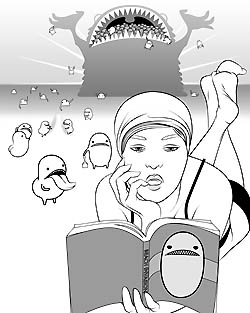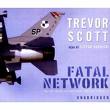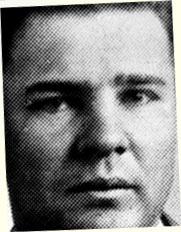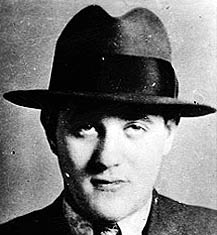|
Irvine Valley College: Online Literature Study of the School of Humanities and Languages Literature 110 - Popular Literature Spring 2013 - Ticket #62740 // Marjorie Coverley Luesebrink, MFA, Instructor
Unit 3b: Detective on the Beat The Big Sleep, Raymond Chandler Intimacy of Style and Tone Genre Novels almost always operate with a sense of close intimacy in terms of the narrative voice. In the case of *The Big Sleep* the narrator is Marlowe, and he is a very accessible guy - for all of his hard-boiled detective exterior. At least he is accessible and chummy with the reader. He tells us where he hides his booze, he tells us what he is wearing, he lets us in on some moment-by-moment sequences. He has a philosophy that is straightforward and scaled to his character in a short novel - and he tells us about it once in a while. I like this quote from the Wikipedia article on him: Underneath the wisecracking, hard drinking, tough private eye, Marlowe is quietly contemplative and philosophical. He enjoys chess and poetry. While he is not afraid to risk physical harm, he does not dish out violence merely to settle scores. Morally upright, he is not bamboozled by the genre's usual femmes fatale, like Carmen Sternwood in The Big Sleep. As Chandler wrote about his detective ideal in general, "I think he might seduce a duchess, and I am quite sure he would not spoil a virgin."
Egg Slicer Structure of Crime/Detective Novels Patterned Structure The plots of most crime and mystery novels are based on a kind of egg slicer model - that is, we start with a section where we establish the narrative Point of View (Marlowe) - and then the story begins to introduce, one by one, various possible perpetrators/criminals (the slicing section of the gadget). As we proceed through the story, each of the suspects is examined for motive and probability. Finally, we narrow the suspects down to one - and the story is over! Chandler does this in rapid and economical fashion - wasting almost no time in getting to the first suspect! In Chandler's books, and in many of the single-detective, gumshoe books, the guilty party will be a single individual. The "motive" might be deep passion, money, anger, or accident. [The kind of motive is often very telling in terms of the value system and submerged meaning of the story! In the case of Carmen Sternwood, for example, we have a motive of confusion and fear and mental illness. She's dangerous, but in a certain LA kind of way?] There is a big difference in what is being "said" in a story depending on why the crime was committed. In typical Police Procedural genre detective stories, the criminal is someone who is a professional, usually - that gives rise to the conviction that crimes are committed by real criminals. In other stories, we have the hapless normal person who is somehow driven, tricked, trapped into murder. That tends to suggest we live in a world of accidental crime; any one of us could find ourselves in the hot seat!
T. Jefferson Parker is a local crime writer! Recommended! Here is cover for *California Girl* Reassuring Plot You might compare the single-killer approach with the "threat" in later, more complicated detective and crime novels. T. Jefferson Parker, for instance, will often have criminal networks (leading to many possible suspects and hangers-on). At the end of a Parker book, we might have stopped a couple of the criminals, but there is always the lurking sense that the syndicate continues to exist, out there, somewhere. That makes for a much less "settled" ending than we have with Chandler or Hammett. Other "International Thriller" (we aren't reading one of these, but we want to be aware of the genre) writers will create a shadowy cabal that we fear will never be really contained. (See: The Website for The International Thrillers Writers' Association.)
Cover for Trevor Scott's *Fatal Network* Chandler's books are mainly very short and spare - for this reason, the plots are carefully sculpted to eliminate anything that might constitute a breach in the predictable rise and fall of the plot action. We rarely have loose ends by the conclusion of the story [note, in *The Big Sleep* the emphasis on getting help for Carmen. She needs to be off the grid in someplace safe for us to be reassured!]. Even in the case of Parker and others who leave a lurking threat out there, the "world" in which the story takes place conforms to the necessities of a Reassuring Plot. We don't finish a detective novel with our heads full of worry about global warming, the economy, the starving poor in Africa, the collapse of reliable health care - none of that. The world is threatened by Crime - but both that, and everything else, can be "solved." It's all about solutions!
Illustration from *Fibonacci's Daughter* - M.D. Coverley (Marjorie Luesebrink) I would like to introduce you to a piece that is not about solutions, although it plays with most of the plot elements of mystery fiction. It is a hypermedia story, authored by yours truly, that attempts both by the use of media techniques, structure, and approach, to challenge the notions of the genre: <http://califia.us/Fibonacci> (think about the egg slicer and then think about a Golden Square) Enjoy! Clear-cut Value System Whenever we are looking at fiction - even popular genre fiction - we can benefit from teasing the author apart from the narrator. Not infrequently, the author has a slightly different, expanded, more subtle value system than does the narrator. Moreover, the value system of the whole book might be a combination of the two. This duality is certainly true in the case of Raymond Chandler and his narrator, Marlowe. Chandler, as we have seen in looking at his biography, has been exposed to a considerable number of sophisticated cultures before he actually publishes *The Big Sleep* at age 51! And yet, we do not see any taint of upscale sophistication in Marlowe. He prides himself on being a down-to-earth guy - has a modest office, does not employ a secretary, makes his own coffee, went to a local college for a couple of years. Marlowe, is, of course, the "witnessing eye" of the story - but in the descriptions of clothes, background, tastes, etc., Chandler let slip a more critical view of the LA culture! For example: on the very first page of *The Big Sleep* Marlowe approaches the main hall of the Sternwood place - "The main hallway of the Sternwood place was two stories high. . . .He didn't seem to be really trying."
Many people in California felt that Hearst Castle was pretty much "over the top." Living, as we do in a democracy, building a castle that rivals any European Monarch was seen as bad taste. This whole passage is a tongue-in-cheek critique of the Sternwood house as being far too ostentatious and over-the-top. My goodness, here we are in low-brow Los Angeles, for pity's sake, and the residents are building houses that are better suited to a French Castle than to the oil-swamp of a western slum! Goodness. The same kind of disparagement takes place with respect to education (note, Marlowe is not supposed to be well educated). In Chapter Four, Marlowe goes to Geiger's shop. He looks at the books in the bookcase and says: ". . . the kind a rich promoter would buy by the yard and have somebody paste his bookplate in." Truth is, of course, only a book snob would even know that this was common practice. And only a well-educated reader would even care! Ha! Not Marlowe, as he is portrayed. It's fun to watch for these discrepancies throughout the story. And, finally, this kind of detail embodies value systems in a story. Marlowe's value system is egalitarian and in tune with the common culture of LA. Chandler values the intellectual and good taste.
Mythological and Folk Referents Urban Detective Fiction seems, in many cases, not to rely very heavily on folk and myth references - unlike some British Crime fiction that might center around these elements. However, even urban American fiction has its relationships to particularly indigenous oral stories and attitudes. I will give you just a few ideas of the kind of thing we sometimes see traces of in Chandler and others. First, of course, although we think of the "Good Robin Hood" as peculiarly English, the American frontier has long had a tradition of the "good robber." The model here is the man who goes wrong and enters a life of crime because of the injustices of society.
Pretty Boy Floyd Pretty Boy Floyd is one of these - legend had it that he often left a thousand-dollar bill after he had dined at the home of a humble farmer. here's a quote about him from the bio website: Floyd, when not busy robbing banks and killing people (at least 10, half of them lawmen), really did give to the poor. He would often sprinkle money out of a car window for the Okies as he and his gang left the scene of a robbery. Unlike his counterparts--Dillinger, the Barker boys, Creepy Karpis, and "Baby Face" Nelson--Floyd had been a hard-working youth and probably never would have become a "public enemy" had he found work in the hard-pressed farm country of Oklahoma, which felt the Depression long before 1929. In *The Big Sleep* we don't have good criminals - but some of the suspects, while rough and unseemly, such as Rusty Regan, Vivian's erstwhile husband, fit a typical American folk-type of the "rough-guy/good-guy." Also, the "bad" criminals have some of the characteristics that are part of the real American/history legendstock of the Gangster Era of the 1920's and 1930's. Eddie Mars, for instance, behaves a lot like a Mafia-type criminal!
Bugsy Seigel - The Las Vegas Mafia: Sophisticated and Smooth
All in all, *The Big Sleep* has almost all of the expected and necessary genre features of the gumshoe, hard-boiled detective novel and some very entertaining surprises thrown in, as well. Again, I recommend renting the movie,too! Lots of the Chandler films are available on Netflix and other sources.
Detective Fiction (one subcategory of Crime Fiction): The detective genre continues to be very popular all over reading-land - and fans seem to be particularly widely read in the field! Some good historical/traditional authors include: Arthur Conan Doyle: http://www.sherlockholmesonline.org/ - Sherlock Holmes is the epitome of the classic detective. Even if you have not read Doyle's books, you probably know a lot about Sherlock! P.D. James: A woman writer, with an amazing knowledge of police procedure, is a perennial favorite. Agatha Christie: A taste for Agatha can be satisfied almost any time - she has written a LOT of books! Raymond Chandler: Raymond Chandler - an author we will be reading, was one of the first "gumshoe" detective genre writers. His books recall a classic period of Los Angeles history. Dashiell Hammett: Another popular traditional California author - his fiction is both "hard-boiled" and "gumshoe."
Marjorie Coverley Luesebrink: write to me with questions!
Marjorie Coverley Luesebrink, MFA, your Instructor, is a Professor of English in the School of Humanities and Languages, Irvine Valley College, Irvine, California. See Online writing at Home Page. |
| MENUBAR: About Your Class // Class Syllabus // Lecture Notes // Reading List // Recommended Reading // Assignments // Grading Policies // Contact Your Instructor // Announcements // Discussion |







